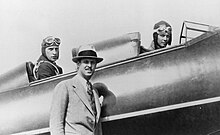Hamilton Metalplane Company
| Thomas F. Hamilton | |
|---|---|

Hamilton in front of Weick and Lindbergh
|
|
| Born |
Thomas Foster Hamilton July 28, 1894 Seattle, Washington, USA |
| Died | August 12, 1969 Good Samaritan Hospital, Los Angeles, California, USA |
| Cause of death | Cardiac arrest |
| Resting place | Forrest Lawn Memorial Park, California, USA |
| Residence | Lake Arrowhead, California, USA |
| Other names | Tom Hamilton |
| Occupation | Aviation Executive |
| Known for | Founder of the Hamilton Standard company, propellers, and early aircraft. Builder of the Malibu Resort at Princess Louisa Inlet. |
| Spouse(s) | Ethal Inez Hughes (1st wife) & Lenora Hamilton (2nd wife) |
| Children | Ethel Mary, Kathryn (Kitten), Thomas Luther II, Lawrence (Larry) |
| Parent(s) | Thomas Luther & Herietta "Etta' Green Hamilton |
Thomas Foster Hamilton (July 28, 1894 – August 12, 1969) was a pioneering aviator and the founder of the Hamilton Standard Company.
Since 1930, Hamilton Standard (now Hamilton Sundstrand) was involved with revolutionizing propulsion technology of propeller-driven aircraft, prior to World War II. The introduction of Frank Caldwell's variable-pitch propeller made Hamilton Standard one of the leading aerospace companies of today. But, there is little known about the first name sake of this company – Thomas Foster Hamilton. Hamilton contributed a great deal in shaping the aviation industry into what it is today. He was involved in the early beginnings of aviation inventions and development. Hamilton worked hard from an early age to the understand technical concepts and their application to aircraft design and manufacturing. He was also a very good businessman and marketer, known in social and political settings, and a devoted family man.
Hamilton was born on July 28, 1894. He spent most of his childhood in Seattle, Washington. He was the older of two boys (his brother, Edgar Charles Hamilton, born later) to his parents (Thomas Luther and Henrietta Hamilton). Hamilton's early interests in aviation began when he was around 10 years old. His mother had taken a trip to see the 1904 St. Louis Exposition, where there was a display of gliders organized by Octave Chanute and, somehow on her return, Hamilton became more focused on aeronautics. Mrs. Hamilton may have made a connection with Chanute at the fair since the young Tom Hamilton did not make the long trip with her. Because, some years later, Hamilton indicated that he often wrote to Chanute concerning technical matters related to his early aircraft. However, currently, no record has been found mentioning the young Hamilton in Chanute's letter collection currently located at the Library of Congress and more research is being conducted since the collection is so vast.
During the 1909 Alaskan-Yukon Exposition, held in Seattle (held on the site of the present-day University of Washington), the young Hamilton, now at the age of 14, had a job of repairing hot-air balloons. This job would also allow him to ride what he repaired (possibly a type of insurance policy to insure the balloons were fixed properly) which helped fuel his continuing interest in aviation. Also, during this time, Hamilton and a school friend, Paul J. Palmer established a partnership and called their company “Hamilton and Palmer”. Their office and factory were located in their respective parents' garage and kitchen tables. The two built and experimented with various biplane glider designs of the time. The two quickly gained a better understanding of the principles of how aircraft worked and were put together. Three gliders were actually built and flown around the steep hills around their neighborhood in Seattle called Leschi which was on the west shores of Lake Washington. There was only one mishap. The second glider jerked out of the hands of Palmer and soared away and crashing into pieces blocks away. Many years later, Hamilton would recall that even though he got a scar on his left hand from one of the flights, he had learned how to fly from those tests.
...
Wikipedia
